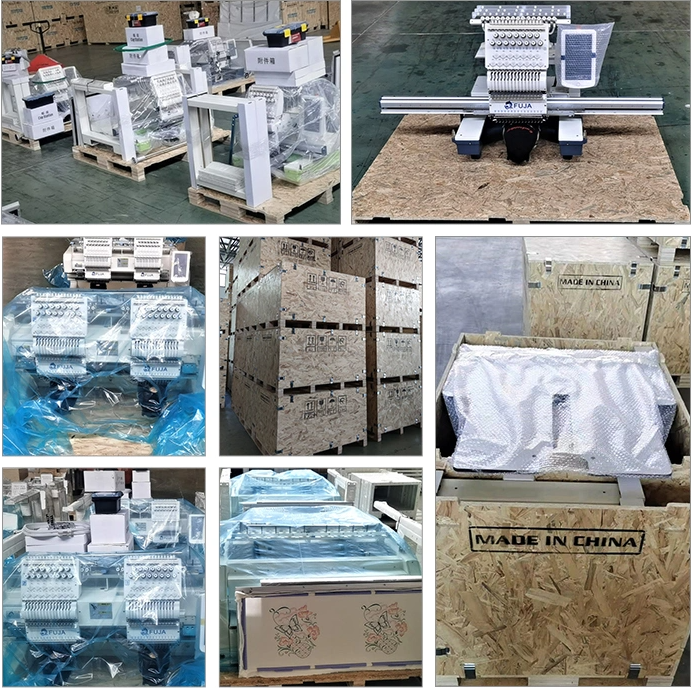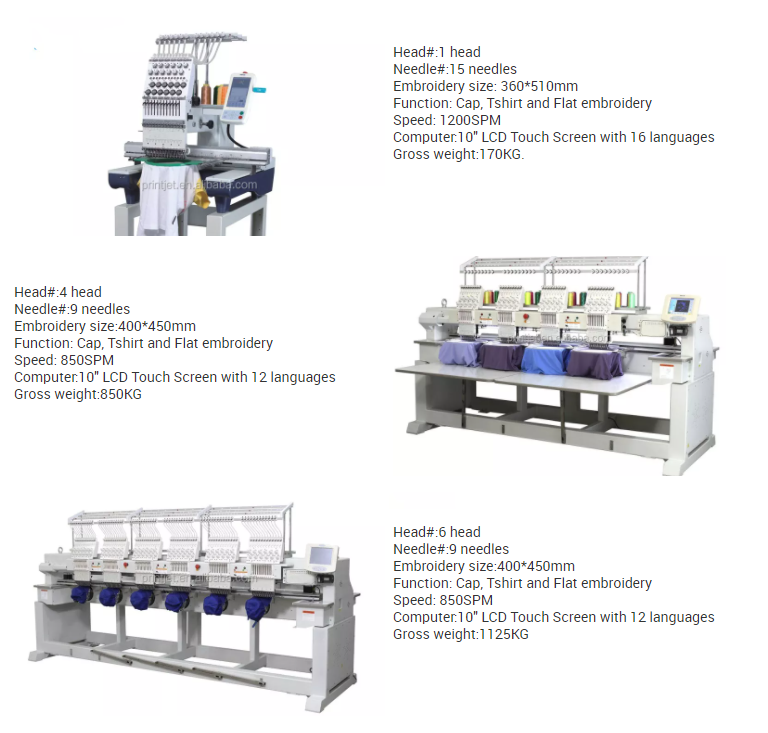ජූලි . 05, 2025 07:14 Back to list
High Speed Computerized Embroidery Machine – 6 Head 15 Needle, Single Head Multifunction for Industrial & T-Shirt Branding
- Introduction to Computerized Embroidery Machine Technology
- Industrial Shifts Driven by High-Speed Computerized Flat Embroidery Machines
- Comparative Analysis: 6 Head vs. Single Head Embroidery Machines
- Key Features and Technical Advantages of Leading Machines
- Customization Strategies and Flexible Manufacturing
- Real-World Applications: Case Studies across Sectors
- How the Computerized Embroidery Machine Factory is Shaping the Future

(computerized embroidery machine)
Introduction to Computerized Embroidery Machine Innovation
In recent years, the computerized embroidery machine
has utterly transformed textile embellishment. Once confined to labor-intensive craftsmanship, the advancing wave of digitalization has elevated productivity and flexibility across industries. According to International Textile Manufacturers Federation, global sales of computerized embroidery machines grew by 24% between 2018 and 2022, driven by automation and an expanding apparel customization market. Businesses, from boutique designers to large apparel makers, leverage these high-tech assets to execute intricate, high-density designs with exceptional accuracy and speed. The core mechanism of these machines merges precision robotics, digital pattern data, and sophisticated needle controls, making them indispensable for achieving consistency, scalability, and operational efficiency. This article will explore the paradigm shift induced by these machines, examining specifications, technological leadership, customization options, and real-world impacts.
Industrial Shifts Driven by High-Speed Computerized Flat Embroidery Machines
One of the pivotal innovations in recent textile manufacturing is the high speed computerized flat 6 head 15 needles embroidery machine. This technology caters directly to mass production environments—notably in home textiles, fashion labels, uniform branding, and sportswear—by enhancing speed, accuracy, and versatility. Production data shows that factories deploying these systems report a 45% decrease in cycle times per garment compared with semi-automatic machines. Operators readily switch between patterns, materials, and colors as each of the six heads hosts 15 needles, supporting rapid job changes without downtime. This agility is crucial in response to rising trends in short-run, highly personalized fashion and textile manufacturing. Furthermore, with automated tension and thread management, error rates and defective units are reduced, boosting overall equipment effectiveness (OEE) to above 94% in optimized production lines.
Comparative Analysis: 6 Head vs. Single Head Embroidery Machines
Businesses selecting an embroidery system are often faced with the choice between high-speed computerized flat 6 head 15 needles embroidery machines and single head computerized embroidery machines for t-shirt logo and label embroidery. The table below presents a detailed comparison to aid in strategic investment decisions:
| Feature | High-Speed 6 Head 15 Needles | Single Head Multifunction Machine |
|---|---|---|
| Max Speed (stitches/min) | 1,200 | 1,000 |
| Power Consumption (kW) | 1.8 | 0.4 |
| Heads / Needles | 6 / 90 | 1 / 15 |
| Daily Output Capacity | Up to 1,200 pieces | 150–200 pieces |
| Footprint (m2) | 6.5 | 1.2 |
| Operator Requirement | 1–2 per unit | 1 per unit |
| Best For | Large-scale orders, multisize designs | Custom logos, small-batch production, prototyping |
| Initial Cost | High (USD 16,000–25,000) | Moderate (USD 5,000–8,000) |
While industrial embroidery machines with multiple heads excel in volume production, single head computerized embroidery machines offer accessibility and flexibility for startups, workshop environments, and custom boutiques. Their compact nature makes them ideal for t-shirt logo, label creation, and on-demand production, complementing larger systems in a diversified manufacturing portfolio.
Key Features and Technical Advantages of Leading Machines
Today’s multifunction embroidery machines integrate advanced mechatronics, robust drive systems, and user-centered software. Several features set leaders apart in this field:
- Needle Positioning Precision: Optical sensors and stepper motor controls achieve thread displacement accuracy within ±0.05mm, crucial for dense, high-resolution designs.
- Digital Pattern Memory: With memory capacities of up to 100 million stitches, machines effortlessly store and repeat complex motifs.
- Smart Thread Management: Automated thread trimming, break detection, and real-time tension adjustment minimize operator interventions and defect rates by up to 67%.
- Connectivity: Modern models support USB, LAN, and Wi-Fi communications for seamless job transfers, remote diagnostics, and integration with ERP/MES systems.
- Energy Efficiency: Inverter-driven motors and efficient LED lighting have reduced total operational power costs by 18% on average since 2020, according to machine manufacturers’ published data.
Customization Strategies and Flexible Manufacturing
Rapid market shifts and increasing demand for personalization have placed a premium on customizable solutions. Top computerized embroidery machine factories now offer modular configurations, which can be adapted to specific production needs. For instance, options for double sequin devices, cording attachments, or taping modules expand the embroidery capabilities beyond classic stitching. Software advancements allow importing a variety of file types (DST, PES, EXP, etc.), maximizing design flexibility and simplifying the prototyping to production transition. These innovations support a batch-of-one manufacturing ethos, where products like sports team uniforms, corporate apparel, and branded gifts are individually crafted, even in high-throughput environments. According to recent industry surveys, over 52% of embroidery companies expanded into new business verticals after adopting flexible, multi-function equipment.
Real-World Applications: Case Studies across Sectors
The versatility of industrial embroidery machines has driven their adoption across diverse industries. The following real-world cases showcase technology impacts:
-
Apparel Manufacturing:
A Bangladesh-based exporter implemented a fleet of high-speed 6 head 15 needle machines, increasing their uniform production by 38%, reducing turnaround time for logo batches by two days. -
Corporate Branding:
A European promotional merchandise firm scaled personalized product lines thanks to single head computerized embroidery machines, bolstering their corporate gifting service and doubling their order volume in one year. -
Technical Textiles:
Automotive seat cover manufacturers integrated advanced multifunction embroidery machines with automated thread monitoring, achieving defect rates below 0.8% across 50,000 units produced monthly. -
Luxury Goods:
Custom lingerie and premium accessory brands utilized compact industrial embroidery machines to create intricate lace and branded accents for international clients, reporting a 28% increase in average order value.
How the Computerized Embroidery Machine Factory is Shaping the Future
Looking forward, the computerized embroidery machine factory will continue to redefine the boundaries of textile decoration, merging digital intelligence, sustainable manufacturing, and global supply responsiveness. The convergence of artificial intelligence for pattern optimization, IoT for predictive diagnostics, and eco-friendly materials will set future leaders apart. As end-clients demand smaller batch sizes, shorter lead times, and sustainable practices, new waves of innovation—such as direct-to-garment embroidery and real-time, cloud-based design collaboration—are on the horizon. Whether for mass production or bespoke items, the industry’s evolution is tightly bound to next-generation computerized embroidery machine technologies, creating unprecedented creative and operational possibilities.

(computerized embroidery machine)
FAQS on computerized embroidery machine
Q: What is a computerized embroidery machine?
A: A computerized embroidery machine is an automated device that uses digital patterns to create embroidery designs. It is much faster and more precise than manual embroidery. These machines can handle complex patterns for industrial and personal use.Q: What are the advantages of a high speed computerized flat 6 head 15 needles embroidery machine?
A: This type of embroidery machine allows multiple designs to be embroidered at once, increasing productivity. With high speed and 15 needles per head, it can manage various thread colors and intricate patterns effortlessly. It’s ideal for industrial embroidery factories seeking efficiency.Q: Is it possible to use a single head computerized embroidery machine for T-shirt logo and label embroidery?
A: Yes, single head computerized embroidery machines are perfect for customizing T-shirts, logos, and labels. They are versatile and suitable for small businesses and niche embroidery services. They offer high-quality, professional results with minimal setup.Q: What makes multifunction embroidery machines different from standard models?
A: Multifunction embroidery machines can perform different types of embroidery tasks, such as applique, monogramming, and 3D puff. They allow businesses to offer a broader range of services. This versatility makes them highly valuable for expanding embroidery production.Q: How do I find a reliable computerized embroidery machine factory?
A: Look for factories with a solid reputation, positive customer reviews, and quality certifications. Many factories offer online catalogs and detailed product information for comparison. Choosing an experienced manufacturer ensures better support and reliable machines.-
Pro T-Shirt Embroidery Machine: Multi-Head, 12 & 15 Needle
NewsAug.21,2025
-
Professional 6 Head Embroidery Machine for High-Volume Production
NewsAug.19,2025
-
Professional Embroidery Machine for T-Shirts & Apparel
NewsAug.18,2025
-
Best Industrial Embroidery Machines for Sale - Computerized, Automatic
NewsAug.17,2025
-
Professional Embroidery Machine: High-Quality T-Shirt Production
NewsAug.16,2025
-
Affordable Computer Embroidery Machine Prices & Deals
NewsAug.15,2025

Copyright © 2025 Xingtai Pufa Trading Co., Ltd All Rights Reserved. Sitemap | Privacy Policy
